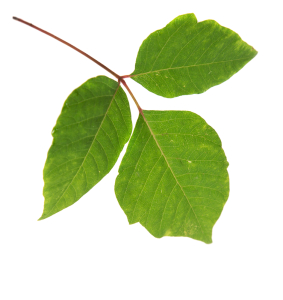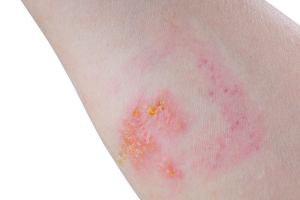 Eczema/atopic dermatitis (AD) and/or contact dermatitis occur when the skin is irritated or inflamed. Since the skin is considered the “second lung”, eczema/AD often precedes or accompanies asthma and allergic rhinitis. Like asthma, it may be acute or chronic. An acute bout related to skin irritant exposure/contact is called contact dermatitis. More chronic forms, often starting in infancy but occurring anytime, are called eczema or atopic dermatitis (AD). Usually, itching, dryness, redness, scaling/thickening, and sometimes fluid-filled blisters and cracking (dyshydrotic eczema) occur. Interestingly, AD is increasing. It correlates with immigrating to and living in developed countries, and has genetic tendencies. As with asthma and food allergies, the hygiene hypothesis (decreased environmental exposure to allergens and organisms) may correspond to increased AD rates in infants.
Eczema/atopic dermatitis (AD) and/or contact dermatitis occur when the skin is irritated or inflamed. Since the skin is considered the “second lung”, eczema/AD often precedes or accompanies asthma and allergic rhinitis. Like asthma, it may be acute or chronic. An acute bout related to skin irritant exposure/contact is called contact dermatitis. More chronic forms, often starting in infancy but occurring anytime, are called eczema or atopic dermatitis (AD). Usually, itching, dryness, redness, scaling/thickening, and sometimes fluid-filled blisters and cracking (dyshydrotic eczema) occur. Interestingly, AD is increasing. It correlates with immigrating to and living in developed countries, and has genetic tendencies. As with asthma and food allergies, the hygiene hypothesis (decreased environmental exposure to allergens and organisms) may correspond to increased AD rates in infants.
Typical AD triggers are similar to allergic rhinitis’s and asthma’s: food, heat, dust mites etc. While no one knows how it occurs, increased skin inflammation clearly causes AD. One theory suggests immune system dysfunction; another suggests skin weakness permits allergens, bacteria, etc. to enter the body, resulting in an immune system over-reaction.
AD is usually recognized visually. When conditions warrant, skin biopsy may be performed to clarify the diagnosis. Contact dermatitis and AD appear similar, but contact dermatitis is caused by an irritant or allergen (like poison ivy or nickel). Chronically inflamed/congested skin tissues make a hospitable environment for bacteria/fungus to grow: acute or sometimes chronic skin infections may develop and require treatment. The chronic itch can be very vexing, even debilitating.
Conventional (Western) Treatment consists of several major strategies: moisturizing (lukewarm bath followed by petrolatum or newer agents like Atopiclair); topical (for AD) or oral (for contact dermatitis) steroids; and topical immunomodulators/immunosuppressives (Elidel/Prograf/Protopic) to block parts of the inflammatory pathway (leukotriene inhibitor/calcineurin inhibitor). Most conventional providers recommend avoiding the most highly allergenic foods (eggs, milk, peanuts, tree nuts), and activities which produce sweating.
The microbiome (naturally occurring bacteria and yeast in and on the body) may  play a role: conventional providers now recommend probiotics to eczema patients. Interestingly, since a child’s immune system begins to develop in utero (Th1 vs Th2 limbs of immune system), children of mothers who took probiotics during pregnancy demonstrate lower levels of IgE antibody (evidence of less over-active immune systems) [2, 28]. Severe disease in adults may be addressed using UV light, as used in psoriasis, or with medications from the anti-cancer class (methotrexate).[1]
play a role: conventional providers now recommend probiotics to eczema patients. Interestingly, since a child’s immune system begins to develop in utero (Th1 vs Th2 limbs of immune system), children of mothers who took probiotics during pregnancy demonstrate lower levels of IgE antibody (evidence of less over-active immune systems) [2, 28]. Severe disease in adults may be addressed using UV light, as used in psoriasis, or with medications from the anti-cancer class (methotrexate).[1]
In Traditional Chinese Medicine (TCM), atopic dermatitis is considered a sign of significant derangement of the body’s overall “balance” (homeostasis); it may indicate a “Wei Qi” (defensive energy /immune system) deficiency, “Heart/Lung System Disharmony” “Internal Cold leading to Deficiency Heat”, “Blood Deficiency”, “Kidney Yin/Jing Deficiency”, and/or “Lung System Excess or Deficiency”. All atopic dermatitis sufferers will likely to benefit from “tonifying Blood and Yin” which form the basis of moisture production. However, because of the multiple causes, different people require different treatments (at different times) to address AD. For example, children respond well to “harmonizing the Heart and Lung Systems”, whereas adults require more substantial “Blood and Yin Tonification”. Both TCM and Ayurveda link heat, food, environmental impurities and excess of heating activities to AD.
As a complex problem, usually multiple treatment modalities are used. Acupuncture starts to balance the system, while Chinese Herbal Medicine more profoundly addresses the underlying problem. Most dramatically, Allergy Relief Acupuncture may actually eliminate or attenuate certain allergic responses, and significantly reduce certain types of AD. Since AD is considered a “deeper” problem in TCM, Chinese herbs require compliance usually for 6-24 months to achieve the longest lasting effects.[2,3]
Learn more about Eczema/Atopic Dermatitis
X
These brief overviews of conditions represent distillations of basic and current medical reviews from the following sources:
[1] Conventional Medical Sources“Harrison’s Principles of Internal Medicine: Volumes 1 and 2, 18th Edition”. Dan Longo Anthony Fauci, Dennis Kasper, Stephen Hauser, J. Jameson, Joseph Loscalzo. McGraw-Hill Professional; (July, 2011)
Medscape eMedicine Physician’s online resource. Various review articles:
Allergic and Environmental Asthma: an Overview of Asthma
William F Kelly III, MD Associate Professor of Medicine, Uniformed Services University of the Health Sciences; Staff physician, Division of Pulmonary/Critical Care Medicine, Department of Medicine, Walter Reed National Military Medical Center
Allergic Rhinitis
Javed Sheikh, MD Assistant Professor of Medicine, Harvard Medical School; Clinical Director, Division of Allergy and Inflammation, Clinical Director, Center for Eosinophilic Disorders, Beth Israel Deaconess Medical Center
Food Allergies
Scott H Sicherer, MD Professor of Pediatrics, Jaffe Food Allergy Institute, Mount Sinai School of Medicine of New York University
Atopic Dermatitis
Brian S Kim, MD Clinical Instructor, Department of Dermatology, Hospital of the University of Pennsylvania, Perelman School of Medicine, University of Pennsylvania
Seborrheic Dermatitis
Samuel T Selden, MD Assistant Professor Department of Dermatology Eastern Virginia Medical School; Consulting Staff, Chesapeake General Hospital; Private Practice
Psoriasis
Jeffrey Meffert, MD Assistant Clinical Professor of Dermatology, University of Texas School of Medicine at San Antonio
Urticaria
M Scott Linscott, MD, FACEP Adjunct Professor of Surgery (Clinical), Division of Emergency Medicine, University of Utah School of Medicine
Cholinergic Urticaria
Robert A Schwartz, MD, MPH Professor and Head, Dermatology, Professor of Pathology, Pediatrics, Medicine, and Preventive Medicine and Community Health, University of Medicine and Dentistry of New Jersey-New Jersey Medical School
- “Acupuncture Energetics: A Clinical Approach for Physicians”. Joseph M. Helms. Medical Acupuncture Publishers; 1st Edition. (1995)
- “Foundations of Chinese Medicine: A Comprehensive Text for Acupuncturists and Herbalists”. Giovanni Maciocia. Churchill Livingstone; 2 Edition (July, 2005).
- “Diagnosis in Chinese Medicine: A Comprehensive Guide”. Giovanni Maciocia. Churchill Livingstone; 1st Edition (January, 2004).
4. “Chinese Scalp Acupuncture”. Jason Ji-shun Hao, Linda Ling-zhi Hao and Honora Lee Wolfe. Blue Poppy Press; 1st Edition. (November, 2011)
5. Ege MJ, Mayer M, Normand AC, Genuneit J, Cookson WO, Braun-Fahrländer C, et al. Exposure to environmental microorganisms and childhood asthma. N Engl J Med. Feb 24 2011;364(8):701-9. [Medline]
6. Tsai JD, Chang SN, Mou CH, Sung FC, Lue KH. Association between atopic diseases and attention-deficit/hyperactivity disorder in childhood: a population-based case-control study. Ann Epidemiol. Apr 2013;23(4):185-8. [Medline].
7. JPEN J Parenter Enteral Nutr. 2012 Jan;36(1 Suppl):68S-75S. doi: 10.1177/0148607111426276
8. Rubio-Tapia A, Kyle RA, Kaplan EL, et al. Increased prevalence and mortality in undiagnosed celiac disease. Gastroenterology.2009;137:88-93.
9. Thompson T. Gluten contamination of commercial oat products in the United States. N Engl J Med. 2004;351:2021-2022.
10. Häuser W, Janke KH, Klump B, Gregor M, Hinz A. Anxiety and depression in adult patients with celiac disease on the gluten free diet. World J Gastroenterol. 2010;16:2780-2787.
11. Am. J. Epidemiol. (2013)178 (12):1721–1730doi:10.1093/aje/kwt234
12. Addolorato G, Di Guida D, De Rossi G, et al. Regional cerebral hypoperfusion in patients with celiac disease. Am J Med. 2004;116:312-317.
13. Sapone A, Lammers KM, Casolaro V, et al. Divergence of gut permeability and mucosal immune gene expression in two glutenassociated conditions: celiac disease and gluten sensitivity. BMC Med. 2011;9:23.
14. Biesiekierski JR, Newnham ED, Irving PM, et al. Gluten causes gastrointestinal symptoms in subjects without celiac disease: a double-blind randomized placebo-controlled trial. Am J Gastroenterol. 2011;106:508-514.
15. Yamini D, Pimentel M. Irritable bowel syndrome and small intestinal bacterial overgrowth. J Clin Gastroenterol. 2010;44:672-675.
16. Wahnschaffe U, Schulzke J-D, Zeitz M, Ullrich R. Predictors of clinical response to gluten-free diet in patients diagnosed with diarrhea-predominant irritable bowel syndrome. Clin Gastroenterol Hepatol. 2007;5:844-850.
17. Hadjivassiliou M, Grunewald RA, Chattopadhyay AK, et al. Clinical, radiological, neurophysiological and neuropatholgical characteristics of gluten ataxia. Lancet. 1998;352:1582-1585.
18. Hadjivassiliou M, Boscolo S, Davies-Jones A, et al. The humoral response in the pathogenesis of gluten ataxia. Neurology. 2002;58:1221-1226.
19. Dieterich W, Ehnis T, Bauer M, et al. Identification of tissue transglutaminase as the autoantigen of celiac disease. Nat Med. 1997;7:797-801.
20. Korponay-Szabo IR, Halttunen T, Szalai Z, et al. In vivo targeting of intestinal and extraintestinal transglutaminase 2 by coeliac autoantibodies. Gut. 2004;53:641-648.
21. Hadjivassiliou M, Maki M, Sanders DS, et al. Autoantibody targeting of brain and intestinal transglutaminase in gluten ataxia. Neurology. 2006;66:373-377.
22. Tengah CP, Lock RJ, Unsworth DJ, Wills A. Multiple sclerosis and occult gluten sensitivity. Neurology. 2004;62:2326-2327.
23. Hadjivassiliou M, Sander DS, Grünewald RA. Multiple sclerosis and occult gluten sensitivity. Neurology. 2005;64:933-934.
24· Lever R, MacDonald C, Waugh P, Aitchison T. Randomised controlled trial of advice on an egg exclusion diet in young children with atopic eczema and sensitivity to eggs. Pediatr Allergy Immunol. Feb 1998;9(1):13-9. [Medline].
25. Branum AM, Lukacs SL. Food allergy among children in the United States. Pediatrics. Dec 2009;124(6):1549-55. [Medline].
26. Fleischer DM, Burks AW, Vickery BP, Scurlock AM, Wood RA, Jones SM, et al. Sublingual immunotherapy for peanut allergy: a randomized, double-blind, placebo-controlled multicenter trial. J Allergy Clin Immunol. Jan 2013;131(1):119-27.e1-7. [Medline]. [Full Text].
27. Hand L. Probiotics may protect infants from allergy, but not asthma. Medscape Medical News [serial online]. August 19, 2013;Accessed August 25, 2013. Available at http://www.medscape.com/viewarticle/809604.
28. Elazab N, Mendy A, Gasana J, Vieira ER, Quizon A, Forno E. Probiotic Administration in Early Life, Atopy, and Asthma: A Meta-analysis of Clinical Trials. Pediatrics. Aug 19 2013;[Medline].
29. O’Connel RA. SPECT brain imaging in psychiatric disorders: current clinical status. In: Grünwald F, Kasper S, Biersack HJ, Möller HJ, eds. Brain SPECT Imaging in Psychiatry. Berlin: de Gruyter; 1995:35-57.
30. Grasby PM, Bench C. Neuroimaging in mood disorders. Curr Opin Psychiatry. 1997;10:73-78.
